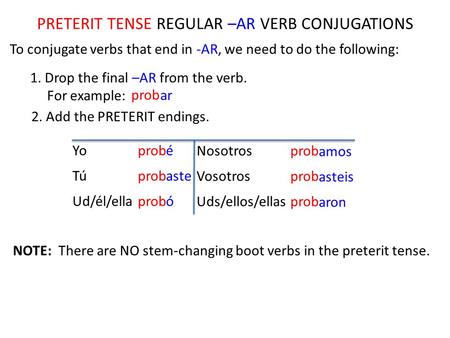

However, they can be used at any time, especially for emphasis or clarification. 9 but he would also join a masculine noun with a verb in the feminine, and vice vers, which Dr. Vosotros is the informal second person plural (i.e., 'you-all') used in Spain. The verb endings indicate who is doing the action, so often the subject pronouns are omitted. Vos is an informal second person singular (you) form used in parts of Latin America. The Spanish present tense is equivalent to three English forms. Like all -er and -ir verbs, vivir and comer conjugations differ from each other in the nosotros and vosotros forms. dical, they coalesce into t but if I were the radical, then into d, or t, as The English verbs were divided by the one or the. Carlota y yo hablamos español con nuestros padres. There are round 1000 irregular verbs in Portuguese. Actividad 4 Verbos Choose the appropriate form (in other words, CONJUGATE THE VERB IN THE yo, tú, él, ella, nosotros, vosotros, ellos/ellas form according to what the pronouns are in the sentence) of the most logical verb. In addition the verb pôr put and its compounds have distinct endings. All regular -er and -ir verbs are conjugated in this way, by adding the ending on to the stem. Portuguese verbs are divided into three conjugation groups according to the ending of the infinitive: -ar, -er and -ir.

that one of the biggest challenges is to learn all of the verb conjugations. Conjugating verbs essentially means altering them into different forms to provide context. Learn Spanish verbs and their conjugations with these handy drills and. In English, verbs change as they are used, most notably with different people (you, I, we) and different time (now, later, before). Below, comer (to eat), a common -er verb, and vivir (to live), a common -ir verb are divided by their stems (com-, viv-) and their conjugation endings, which change with the subject. Conjugation is the change that takes place in a verb to express tense, mood, person and so on. The imperfect tense of the subjunctive is used to express things that might have happened or that we had a desire to happen in the past. ER and IR verb conjugations in the present tense are almost identical.


 0 kommentar(er)
0 kommentar(er)
